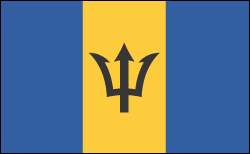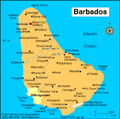Barbados | Facts & Information

- Barbados Profile
- History
Infoplease has everything you need to know about Barbados. Check out our country profile, full of essential information about Barbados's geography, history, government, economy, population, culture, religion and languages. If that's not enough, click over to our collection of world maps and flags.
Facts & Figures
-
Sovereign: Queen Elizabeth II (1952)
Governor-General: Sir Elliot Belgrave (2012)
Prime Minister: Freundel Stuart (2010)
Land area: 166 sq mi (430 sq km); total area 166 sq mi (431 sq km)
Population (2014 est.): 289,680 (growth rate: 0.33%); birth rate: 11.97/1000; infant mortality rate: 10.93/1000; life expectancy: 74.99
Capital and largest city (2011 est.): Bridgetown, 122,000
Monetary unit: Barbados dollar
Language: English (official), Bajan (English-based creole language, widely spoken in informal settings)
Ethnicity/race: black 92.4%, white 2.7%, mixed 3.1%, East Indian 1.3%, other 0.2%, unspecified 0.2% (2010 est.
Religions: Protestant 66.3% (includes Anglican 23.9%, other Pentecostal 19.5%, Adventist 5.9%, Methodist 4.2%, Wesleyan 3.4%, Nazarene 3.2%, Church of God 2.4%, Baptist 1.8%, Moravian 1.2%, other Protestant .8%), Roman Catholic 3.8%, other Christian 5.4% (includes Jehovah's Witness 2.0%, other 3.4%), Rastafarian 1%, other 1.5%, none 20.6%, unspecified 1.2% (2010 est.)
National Holiday: Independence Day, November 30
Literacy rate: 99.7% (2012 est.)
Economic summary: GDP/PPP (2013 est.): $7.004 billion; per capita: $25,100. Real growth rate: –0.8%. Inflation: 2.1% (2011 est.). Unemployment: 11.4% (2011 est.). Arable land: 27.91%. Agriculture: sugarcane, vegetables, cotton. Labor force: 141,800 (2013 est.); services 75%, industry 15%, agriculture 10% (1996 est.). Industries: tourism, sugar, light manufacturing, component assembly for export. Natural resources: petroleum, fish, natural gas. Exports: $1.051 billion (2013 est): sugar and molasses, rum, other foods and beverages, chemicals, electrical components. Imports: $1.674 billion (2013 est.): consumer goods, machinery, foodstuffs, construction materials, chemicals, fuel, electrical components. Major trading partners: U.S., UK, Trindad and Tobago, St. Lucia, Jamaica, St. Vincent and the Grenadines, Antigua and Barbuda, St. Kitts and Nevis, China (2012).
Member of Commonwealth of Nations
Communications: Telephones: main lines in use: 144,000 (2012); mobile cellular: 347,000 (2012). Broadcast media: government-owned Caribbean Broadcasting Corporation (CBC) operates the lone terrestrial TV station; CBC also operates a multi-channel cable TV subscription service; roughly a dozen radio stations, consisting of a CBC-operated network operating alongside privately owned radio stations (2007). Internet hosts: 1,524 (2012). Internet users: 188,000 (2008).
Transportation: Railways: 0 km. Highways: total: 1,600 km; paved: 1,600 km (2012). Ports and harbors: Bridgetown. Airports: 1 (2013).
International disputes: Barbados and Trinidad and Tobago abide by the April 2006 Permanent Court of Arbitration decision delimiting a maritime boundary and limiting catches of flying fish in Trinidad and Tobago's exclusive economic zone; joins other Caribbean states to counter Venezuela's claim that Aves Island sustains human habitation, a criterion under the UN Convention on the Law of the Sea, which permits Venezuela to extend its Economic Exclusion Zone/continental shelf over a large portion of the eastern Caribbean Sea









